The Harris County Marker Program is administered by the Harris County Historical Commission with all research vetted and approval determined locally. The following is a list of the Harris County markers that have been approved and dedicated.

The Founding of Harris County - Marker Dedicated May 24, 2012
Marker Text:
In December 1835 near the beginning of the Texas Revolution, the new Provisional Government of Texas defined the boundary of the Municipality of Harrisburg, similar to the extent of Harris County today. Its largest town and seat of government was then Harrisburg, founded by John Richardson Harris in 1826. The municipalities became counties in the 1836 Texas Constitution.
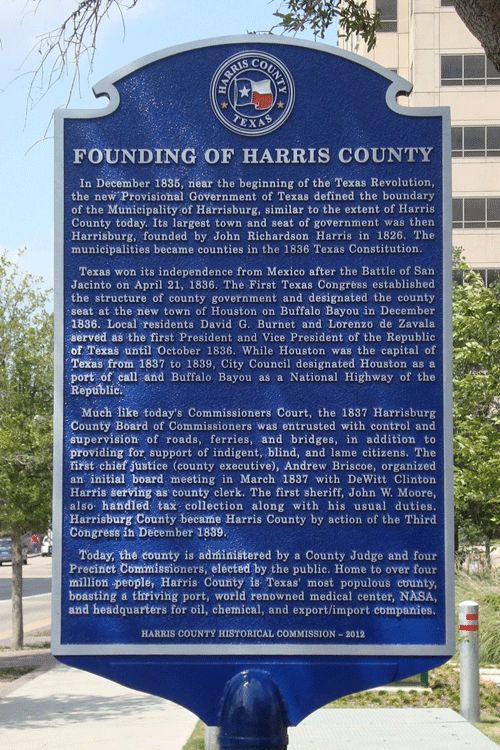 Texas won its independence from Mexico after the Battle of San Jacinto on April 21, 1836. The first Texas Congress established the structure of county government and designated the county seat the new town of Houston December 1836. Local residents David G. Burnet and Lorenzo de Zavala served as the first President and Vice President of the Republic of Texas until October 1836. While Houston was the capital of Texas from 1837 to 1839, City Council designated Houston as a port of call and Buffalo Bayou as a National Highway of the Republic.
Texas won its independence from Mexico after the Battle of San Jacinto on April 21, 1836. The first Texas Congress established the structure of county government and designated the county seat the new town of Houston December 1836. Local residents David G. Burnet and Lorenzo de Zavala served as the first President and Vice President of the Republic of Texas until October 1836. While Houston was the capital of Texas from 1837 to 1839, City Council designated Houston as a port of call and Buffalo Bayou as a National Highway of the Republic.
Much like today’s Commissioners Court, the 1837 Harrisburg County Board of Commissioners was entrusted with control and supervision of roads, ferries, and bridges, in addition to providing for support of the indigent, blind and lame citizens. The first chief justice (county executive) Andrew Briscoe, organized an initial board meeting in March 1837 with DeWitt Clinton Harris serving as county clerk. The first sheriff, John W. Moore, also handled tax collection along with his usual duties. Harrisburg County became Harris County by action of the Third Congress in December 1839.
Today the county is administered by a county Judge and four Precinct Commissioners, elected by the public. Home to over four million people, Harris County is Texas’ most populous county, boasting a thriving port, world renowned medical center, NASA, and headquarters for oil, chemical and export/import companies.
Marker Text with Citations Dedication Program

Phillis Wheatley High School - Marker Dedicated 2012
Marker Text:
Phillis Wheatley High School, Houston’s third oldest high school for blacks, is named for Phillis Wheatley (1753-1784), renowned African-American poet and author. The first campus, located at 3415 Lyons Avenue in the Fifth Ward, was the former McGowan Elementary School building for white students. It opened on January 31, 1927 with 490 students and 20 teachers, led by Principal E. O. Smith. In 1929, a new building designed by Harry D. Payne was constructed on the Lyons Avenue Campus.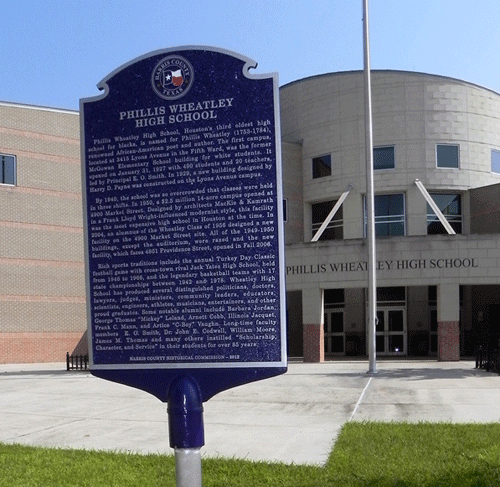
By 1940, the school was so overcrowded that classes were held in three shifts. In 1950, a $2.5 million 14 acre campus opened at 4900 Market Street. Designed by architects MacKie and Kamrath in a Frank Lloyd Wright-influenced modernist style, this facility was the most expensive high school in Houston at the time. In 2004 Wheatley alumnus Willie Jordan designed a facility on the 4900 Market Street site. All of the 1949-1950 buildings, except the auditorium, were razed and the new facility, which faces 4801 Providence Street, opened in Fall 2006.
Rich sports traditions include the annual Turkey Day Classic football game with cross-town rival jack Yates High School, held from 1946 to 1966, and the legendary basketball teams with 17 state championships between 1942 and 1978. Wheatley high School has produced several distinguished politicians, doctors, lawyers, judges, ministers, community leaders, educators, scientists, engineers, athletes, musicians, entertainers, and other proud graduates. Some notable alumni include Barbara Jordan, George Thomas “Mickey” Leland, Arnett Cobb, Illinois Jacquet, and Frank C. Mann. Long-time faculty members E. O. Smith, Dr. John E. Codwell, William Moore, James M. Thomas and many others instilled “Scholarship, Character, and Service” in their students for over 85 years.
Marker Narrative

West End Park - Marker Dedicated February 20, 2014
Marker Text:
West End Park was the second baseball park for the Buffaloes, Houston’s professional Texas League ball club. Opened in April 1905 with the home plate entrance at Andrews and Heiner on the San Felipe street car line, this was the most significant sports venue in the city for over two decades. Many of Baseball’s Hall of Fame players,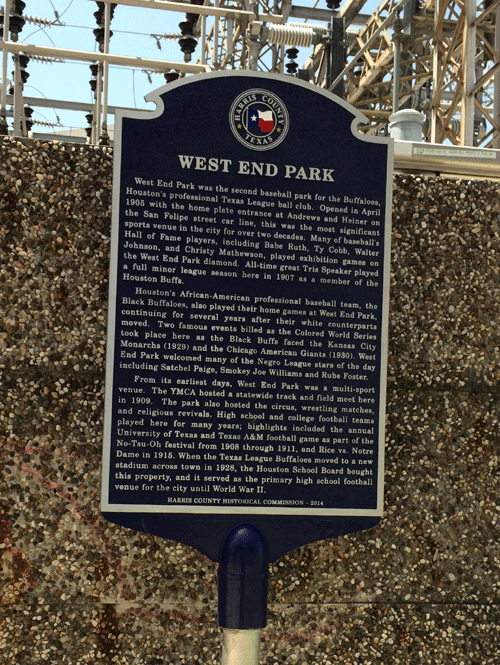 including Babe Ruth, Ty Cobb, Walter Johnson, and Christy Mathewson, played exhibition games on the West End Park diamond. All-time great Tris Speaker played a full minor league season here in 1907 as a member of the Houston Buffs.
including Babe Ruth, Ty Cobb, Walter Johnson, and Christy Mathewson, played exhibition games on the West End Park diamond. All-time great Tris Speaker played a full minor league season here in 1907 as a member of the Houston Buffs.
Houston’s African-American professional baseball team, the Black Buffaloes, also played their home games at West End Park, continuing for several years after their white counterparts moved. Two famous events billed as the Colored World Series took place here as the Black Buffs faced the Kansas City Monarchs (1929) and the Chicago American Giants (1930). West End Park welcomed many of the Negro League starts of the day including Satchel Paige, Smokey Joe Williams, and Rube Foster.
From its earliest days, West End Park was a multi-sport venue. The YMCA hosted a statewide track and field meet here and religious revivals. High school and college football teams played here for many years; highlights included the annual University of Texas and Texas A&M football game as part of the No-Tsu-Oh festival from 1908 through 1911, and Rice vs. Notre Dame in 1915. When the Texas League Buffaloes moved to a new stadium across town in 1928, the Houston School board bought this property, and it served as the primary high school football venue for the city until World War II.
Marker Narrative Invitation

Spring Creek Park Cemetery
West Chapel Methodist Episcopal Cemetery
Marker Text:
This cemetery, appropriately named “Spring Creek Cemetery” since the majority of its northern and western boundaries follows the meanders of Spring Creek, had its beginning February 23, 1884. On that date, Henry Scherer sold 6.6 acres of his farm homestead to the local West Chapel Methodist Episcopal Church of Spring Creek, an African American organization. The deed noted that it was Scherer’s desire to promote public morality and religion and it was common knowledge that the land was to be used to house a Church building and cemetery.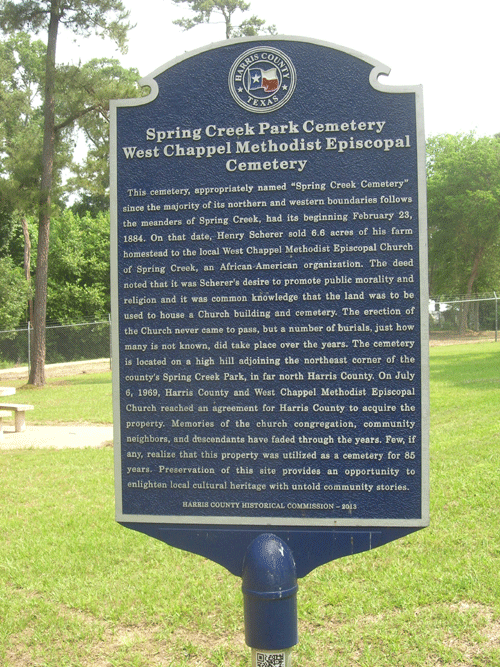 The erection of the Church never came to pass, but a number of burials, just how many is not known, did take place over the years. The cemetery is located on a high hill adjoining the northeast corner of the county’s Spring Creek Park, in far north Harris County. On July 6, 1969, Harris County and West Chapel Methodist Episcopal Church reached an agreement for Harris County to acquire the property. Memories of the church congregation, community neighbors, and descendants have faded through the years. Few, if any, realize that this property was utilized as a cemetery for 85 years. Preservation of this site provides an opportunity to enlighten local cultural heritage with untold community stories.
The erection of the Church never came to pass, but a number of burials, just how many is not known, did take place over the years. The cemetery is located on a high hill adjoining the northeast corner of the county’s Spring Creek Park, in far north Harris County. On July 6, 1969, Harris County and West Chapel Methodist Episcopal Church reached an agreement for Harris County to acquire the property. Memories of the church congregation, community neighbors, and descendants have faded through the years. Few, if any, realize that this property was utilized as a cemetery for 85 years. Preservation of this site provides an opportunity to enlighten local cultural heritage with untold community stories.
Marker Narrative

Morse-Bragg Cemetery - Marker Dedicated May 23, 2017
Marker Text:
The permanent settlement of this vicinity began with the construction of the San Felipe to Harrisburg wagon road in 1830, which lay half a mile south of here. Connecticut-born Agur Tomlinson Morse (1801 – 1865) and his wife Grace Baldwin Morse (1814 – 1890) left their cotton plantation in Mississippi and founded the Pleasant Bend plantation in 1851. Their house lay about five hundred feet to the south. Agur built a grist mill and a cotton gin, and two sons built a steam sawmill. Their land holdings grew to nearly eight square miles, including much of modern Tanglewood, Post Oak-Galleria, River Oaks, West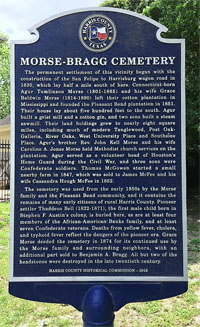 University Place and Southside Place. Agur’s brother Rev. John Kell Morse and his wife Caroline A. Jones Morse held Methodist church services on the plantation. Agur served as a volunteer head of Houston’s Home Guard during the Civil War, and three sons were Confederate soldiers. Thomas McGowen started a small nearby farm in 1847, which was old to James McFee and his wife Cassandra Hough McFee in 1852.
University Place and Southside Place. Agur’s brother Rev. John Kell Morse and his wife Caroline A. Jones Morse held Methodist church services on the plantation. Agur served as a volunteer head of Houston’s Home Guard during the Civil War, and three sons were Confederate soldiers. Thomas McGowen started a small nearby farm in 1847, which was old to James McFee and his wife Cassandra Hough McFee in 1852.
The cemetery was used from the early 1850s by the Morse family and the Pleasant Bend community, and it contains the remains of many early citizens of rural Harris County. Pioneer settler Thaddeus Bell (1822 – 1871), the first male child born in Stephen F. Austin’s colony, is buried here, as are at least four members of the African-American Banks family, and at least seven Confederate veterans. Deaths from yellow fever, cholera, and typhoid fever reflect the dangers of the pioneer era. Grace Morse deeded the cemetery in 1874 for its continued use by the Morse family and surrounding neighbors, with an additional part sold to Benjamin A. Bragg. All but two of the headstones were destroyed in the late twentieth century.
Marker Narrative Marker Program

Sixth Church of Christ, Scientist - Marker Dedication June 23, 2017
Marker Text:
Houston’s first African-American Christian Science congregation was organized in 1914 when founding members Wesley and Patsy Gales, Aurelia and John Snell, Florence Frazier, Alice Jackson, Minerva Thomas, and W. E. Bartlett met in the Gales’ home, 1419 Grove Street, in the Fifth Ward. The group was enlightened by the teachings of Mary Baker Eddy, founder of Christian Science and author of Science and Health with Key to the Scriptures. In 1927, as attendance grew, a cottage was built at 1417 Grove Street. The church was formally recognized by The Mother Church in Boston, Massachusetts, on May 23, 1940, as the “Christian Science Society (Colored), of Houston, Texas.”
The group incorporated under the same name early in 1941, and later that year a new modernistic structure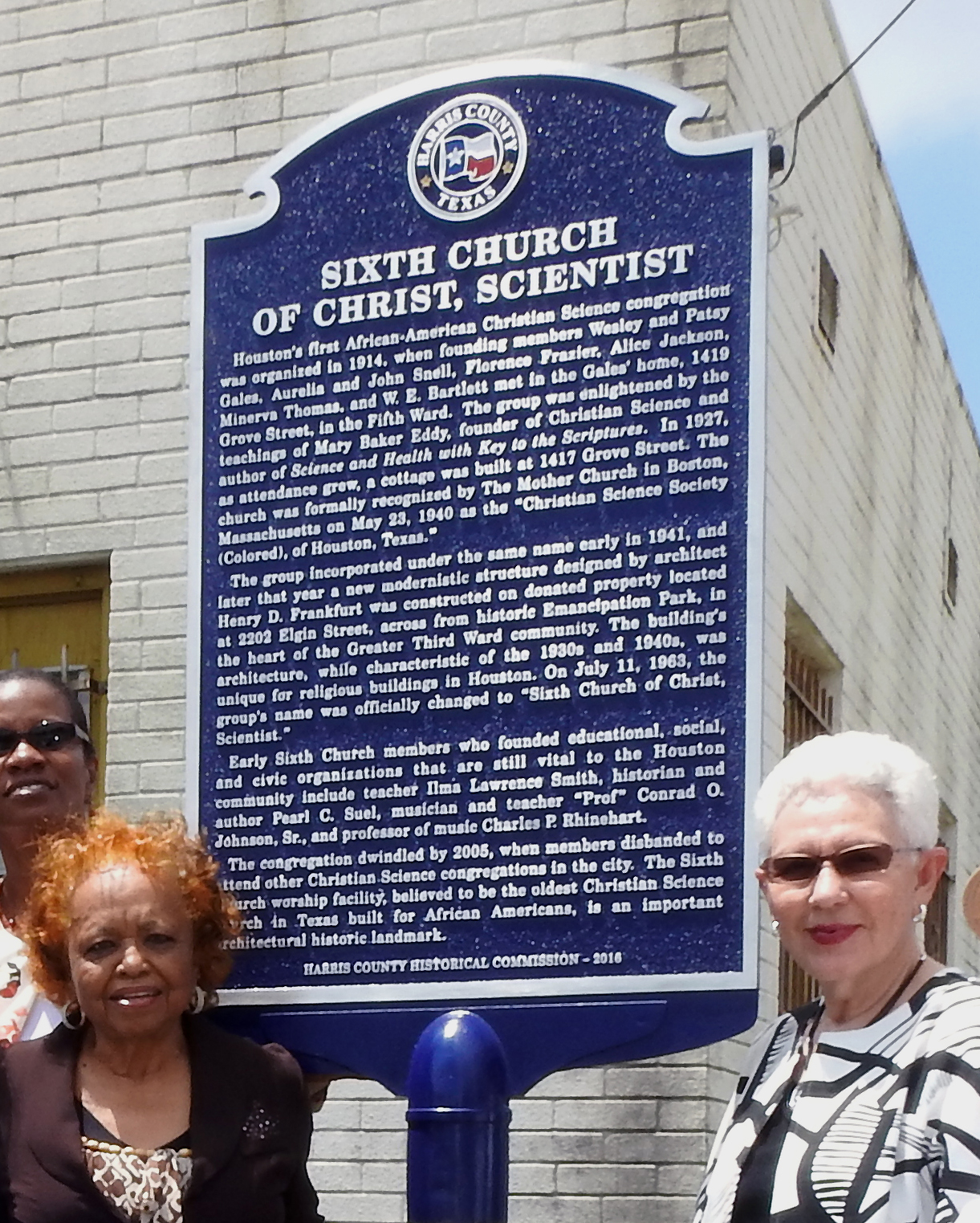 designed by architect Henry D. Frankfurt was constructed on donated property located at 2202 Elgin Street, across from historic Emancipation Park, in the heart of the Greater Third Ward community. The building’s architecture, while characteristic of the 1930s and 1940s was unique for religious buildings in Houston. On July 11, 1963, the group’s name was officially changed to “Sixth Church of Christ, Scientist.”
designed by architect Henry D. Frankfurt was constructed on donated property located at 2202 Elgin Street, across from historic Emancipation Park, in the heart of the Greater Third Ward community. The building’s architecture, while characteristic of the 1930s and 1940s was unique for religious buildings in Houston. On July 11, 1963, the group’s name was officially changed to “Sixth Church of Christ, Scientist.”
Early Sixth Church members who founded educational, social, and civic organizations that are still vital to the Houston community include teacher Ilma Lawrence Smith, historian and author Pearl C. Suel, musician and teacher “Prof” Conrad O. Johnson, Sr., and professor of music Charles P.l Rhinehart.
The congregation dwindled by 2005, when members disbanded to attend other Christian Science congregations in the city. The Sixth Church worship facility, believed to be the oldest Christian Science church in Texas built for African Americans is an important architectural historic landmark.
Marker Narrative Marker Program Program Photographs

Site of Katy’s First Schoolhouse - Marker Dedicated November 10, 2017
Marker Text:
The first public schoolhouse in the new town of Katy was built on this site in 1898 to serve the children of local farmers, ranchers, and railroad workers. That wooden one-room school building was destroyed in the 1900 hurricane, and rebuilt. As the town grew, a permanent two-story red brick schoolhouse was constructed in 1909, complete with a bell. The Katy Independent School District was established in 1918, incorporating several of the 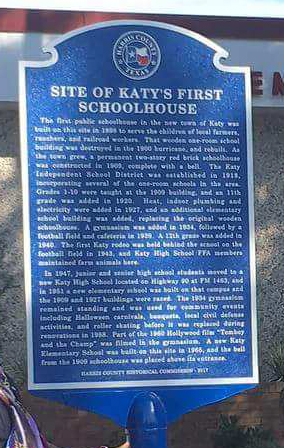 one-room schools in the area. Grades 1 – 10 were taught at the 1909 building, and an 11th grade was added in 1920. Heat, indoor plumbing and electricity were added in 1927, and an additional elementary school building was added, replacing the original wooden schoolhouse. A gymnasium was added in 1934, followed by a football field and cafeteria in 1939. A 12th grade was added in 1940. The first Katy rodeo was held behind the school on the football field in 1943, and Katy High School FFA members maintained farm animals here.
one-room schools in the area. Grades 1 – 10 were taught at the 1909 building, and an 11th grade was added in 1920. Heat, indoor plumbing and electricity were added in 1927, and an additional elementary school building was added, replacing the original wooden schoolhouse. A gymnasium was added in 1934, followed by a football field and cafeteria in 1939. A 12th grade was added in 1940. The first Katy rodeo was held behind the school on the football field in 1943, and Katy High School FFA members maintained farm animals here.
In 1947, junior and senior high school students moved to a new Katy High School located on Highway 90 at FM 1463, and in 1951 a new elementary school was built on that campus and the 1909 and 1927 buildings were razed. The 1934 gymnasium remained standing and was used for community events including Halloween carnivals, banquets, local civil defense activities, and roller skating before it was replaced during renovations in 1988. Part of the 1960 Hollywood film “Tomboy and the Champ” was filmed in the gymnasium. A new Katy Elementary School was built on this site in 1965, and the bell from the 1909 school house was placed above its entrance.
Marker Narrative Program Photographs

Memorial Villages Heritage Trail Markers
Trail Narrative Trail Map Dedication Ceremonies
Early Settlers of Piney Point
(located in Arrowwood Circle, City of Piney Point Village)
Marker Text:
“Piney Point,” named for a grove of tall pines at a southward bulge of Buffalo Bayou, was a landmark for early Texan colonists. The San Felipe Trail was initially a primitive path that followed the south bank of Buffalo Bayou. John D. Taylor arrived in Texas in 1822 and was granted a league of land here by empresario Stephen F. Austin in 1824. Taylor and his wife Maria built a log cabin near a spring, about 1000 feet east of this site.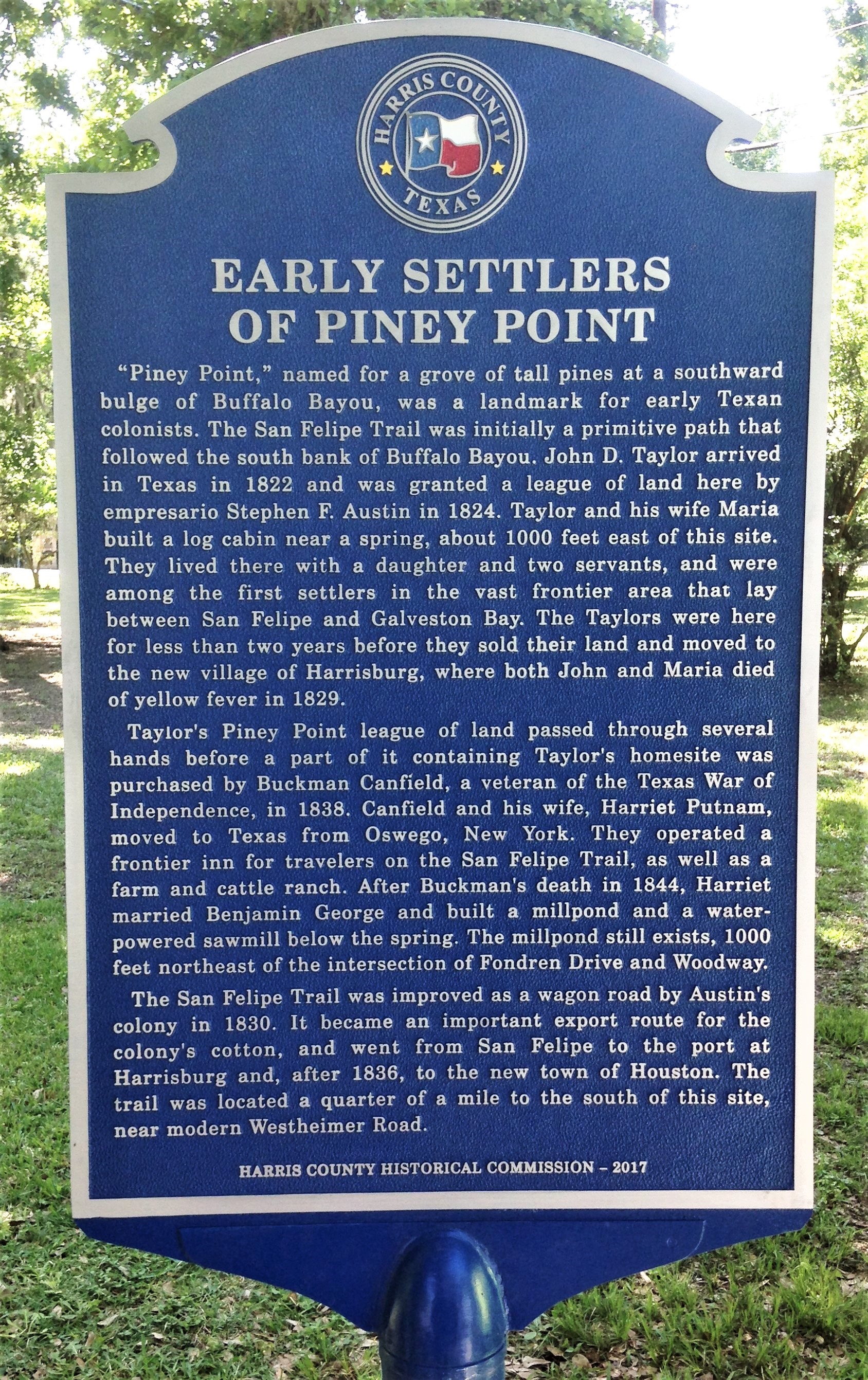 They lived here with a daughter and two servants, and were among the first settlers in the vast frontier area that lay between San Felipe and Galveston Bay. The Taylors were here for less than two years before they sold their land and moved to the new village of Harrisburg, where both John and Maria died of yellow fever in 1829.
They lived here with a daughter and two servants, and were among the first settlers in the vast frontier area that lay between San Felipe and Galveston Bay. The Taylors were here for less than two years before they sold their land and moved to the new village of Harrisburg, where both John and Maria died of yellow fever in 1829.
Taylor's Piney Point league of land passed through several hands before a part of it containing Taylor’s homesite was purchased by Buckman Canfield, a veteran of the Texas War of Independence, in 1838. Canfield and his wife, Harriet Putnam, moved to Texas from Oswego, New York. They operated a frontier inn for travelers on the San Felipe Trail, as well as a farm and cattle ranch. After Buckman's death in 1844, Harriett married Benjamin George and built a millpond and a water-powered sawmill below the spring. The millpond still exists, 1000 feet northeast of the intersection of Fondren Drive and Woodway.
The San Felipe Trail was improved as a wagon road by Austin's colony in 1830. It became an important export route for the colony's cotton, and went from San Felipe to the port at Harrisburg and, after 1836, to the new town of Houston. The trail was located a quarter of a mile to the south of this site, near modern Westheimer Road.
Jacob Schroeder and the Early Spring Branch Community
(located on Gaylord Street between Echo Lane and Piney Point Road, City of Hedwig Village)
Marker Text:
The earliest Europeans to settle in the Spring Branch area were Jacob Schroeder and his wife Dorothea. They arrived in Houston from Germany in about 1838, bringing two children. In 1839, Jacob applied for a Republic of Texas land grant of 640 acres, and the family built a log cabin in an unpopulated area on the Isaac Bunker tract, a few hundred feet northwest of this point. Their cabin was built on a tallgrass prairie, just to the north of a pine fo rest. Jacob raised corn and kept milk cows, sheep and hogs.
rest. Jacob raised corn and kept milk cows, sheep and hogs.
Jacob Schroeder was a founding member of the German Society of Texas, which was incorporated in Houston in 1840. By the late 1840s, there were many German settlers coming into the area, fleeing war and poverty in Europe. In 1848, the Carl Wilhelm Rummel and Carl Siegismund Bauer families arrived from Germany late in the year with plans to settle near a grove of oaks, now the location of St. Peter Church on Long Point Road. Facing a difficult winter with inadequate shelter, the Schroeder family hosted the new arrivals until their own cabins were built.
The Schroeder’s son Fritz built a frame house in about 1865, along what is now Smithdale Road. He owned a farm there, on a part of the John Taylor League. That house was moved to 435 Piney Point Road in 1992, where it sits today. Fritz Schroeder’s son Henry inherited part of the farm, and married Hedwig Jankowski. The surrounding rural area began to be developed in the 1950s. Henry’s widow Hedwig donated the land to Harris County for what became Hedwig and Smithdale Roads. Today, Hedwig Village bears her name.
The Fritz Schroeder Home
(located on 435 Piney Point Road, City of Piney Point Village)
Marker Text:
The first settlers in the Spring Branch area were Jacob and Dorothea Schroeder, who built a log cabin in about 1839 in what is now Hedwig Village. Their son, Friedrich “Fritz” Schroeder (1833-ca. 1903) was born in G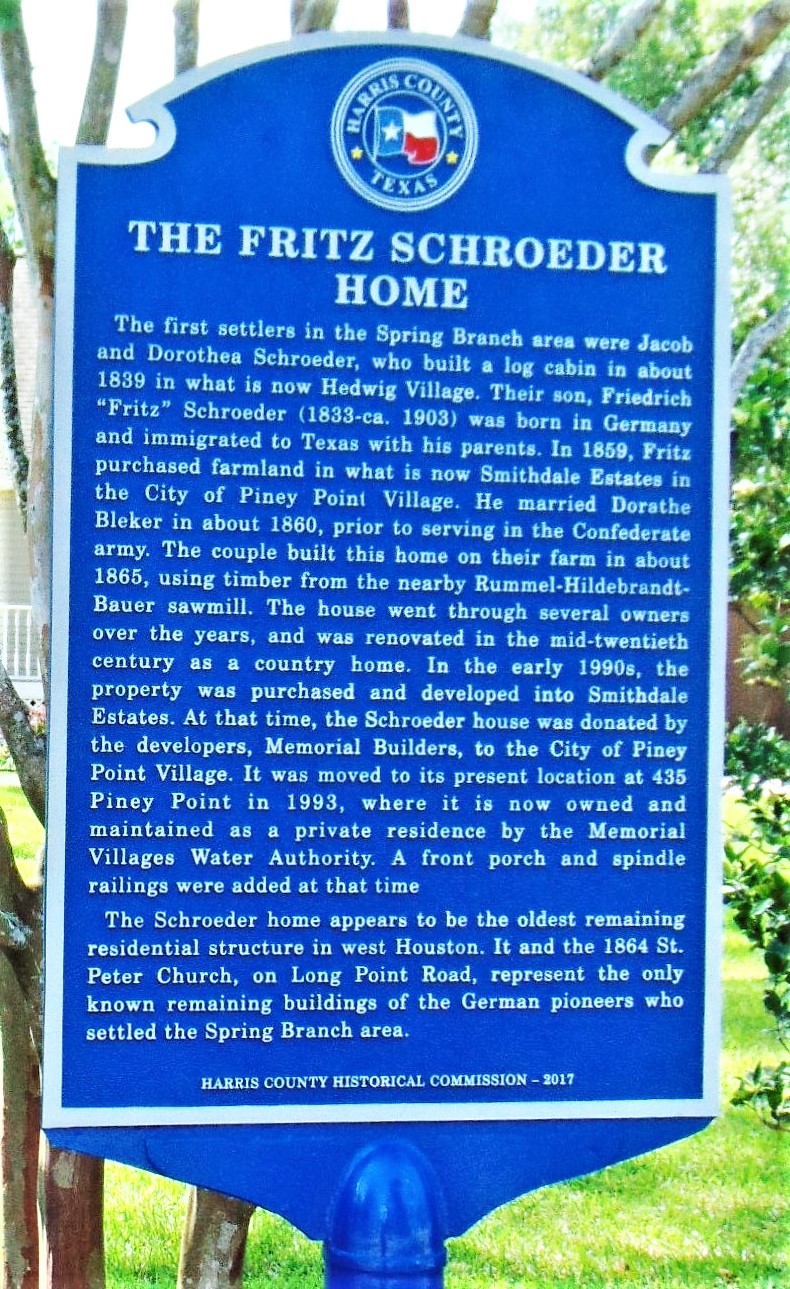 ermany and immigrated to Texas with his parents. In 1859, Fritz purchased farmland in what is now Smithdale Estates in the City of Piney Point Village. He married Dorathe Bleker in about 1860, prior to serving in the Confederate army. The couple built this home on their farm in about 1865, using timber from the nearby Rummel-Hildebrandt-Bauer sawmill. The house went thorough several owners over the years, and was renovated in the mid-twentieth century as a country home. In the early 1990s, the property was purchased and developed into Smithdale Estates. At that time, the Schroeder house was donated by the developers, Memorial Builders, to the City of Piney Point Village. It was moved to its present location at 435 Piney Point in 1993, where it is now owned and maintained as a private residence by the Memorial Villages Water Authority. A front porch and spindle railings were added at that time.
ermany and immigrated to Texas with his parents. In 1859, Fritz purchased farmland in what is now Smithdale Estates in the City of Piney Point Village. He married Dorathe Bleker in about 1860, prior to serving in the Confederate army. The couple built this home on their farm in about 1865, using timber from the nearby Rummel-Hildebrandt-Bauer sawmill. The house went thorough several owners over the years, and was renovated in the mid-twentieth century as a country home. In the early 1990s, the property was purchased and developed into Smithdale Estates. At that time, the Schroeder house was donated by the developers, Memorial Builders, to the City of Piney Point Village. It was moved to its present location at 435 Piney Point in 1993, where it is now owned and maintained as a private residence by the Memorial Villages Water Authority. A front porch and spindle railings were added at that time.
The Schroeder home appears to be the oldest remaining residential structure in west Houston. It and the 1864 St. Peter Church, on Long Point Road, represent the only remaining buildings of the German pioneers who settled the Spring Branch area.
The Rummel-Hildebrandt-Bauer Sawmill
(located at Hunters Creek Village City Hall, 1 Hunters Creek Place, City of Hunters Creek Village)
Marker Text:
The area of Hunters Creek Village and most of the rest of the Memorial Villages were covered with virgin pine forest when German settlers began arriving to the area north of Buffalo Bayou in the late 1840s. By around 1860, a s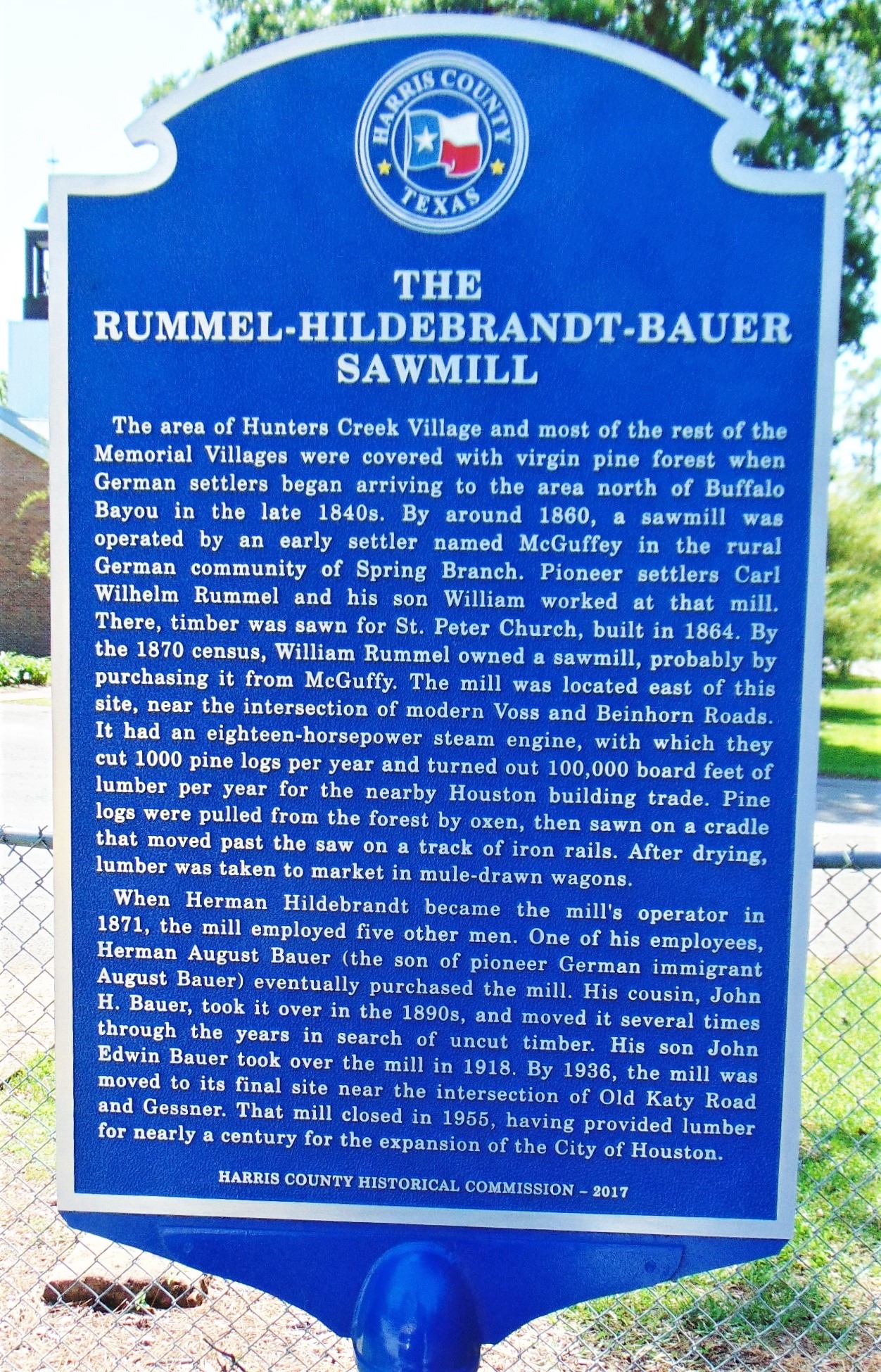 awmill was operated by an early settler named McGuffey in the rural German community of Spring Branch. Pioneer settlers Carl Wilhelm Rummel and his son William worked at that mill. There, timber was sawn for St. Peter Church, built 1864. By the 1870 census, William Rummel owned a sawmill, probably by purchasing it from McGuffey. The mill was located east of this site, near the intersection of modern Voss and Beinhorn Roads. It had an eighteen-horsepower steam engine, with which they cut 1000 pine logs per year and turned out 100,000 board feet of lumber per year for the nearby Houston building trade. Pine logs were pulled from the forest by oxen, then sawn on a cradle that moved past the saw on a track of iron rails. After drying, lumber was taken to market in mule-drawn wagons.
awmill was operated by an early settler named McGuffey in the rural German community of Spring Branch. Pioneer settlers Carl Wilhelm Rummel and his son William worked at that mill. There, timber was sawn for St. Peter Church, built 1864. By the 1870 census, William Rummel owned a sawmill, probably by purchasing it from McGuffey. The mill was located east of this site, near the intersection of modern Voss and Beinhorn Roads. It had an eighteen-horsepower steam engine, with which they cut 1000 pine logs per year and turned out 100,000 board feet of lumber per year for the nearby Houston building trade. Pine logs were pulled from the forest by oxen, then sawn on a cradle that moved past the saw on a track of iron rails. After drying, lumber was taken to market in mule-drawn wagons.
When Herman Hildebrandt became the mill’s operator in 1871, the mill employed five other men. One of his employees, Herman August Bauer (the son of pioneer German immigrant August Bauer) eventually purchased the mill. His cousin, John H. Bauer, took it over in the 1890s, and moved it several times through the years, in search of uncut timber. His son John Edwin Bauer took over the mill in 1918. By 1936, the mill was moved to its final site near the intersection of Old Katy Road and Gessner. That mill closed in 1955, having provided lumber for nearly a century for the expansion of the City of Houston.
St. Peter Cemetery
(located at St. Peter United Church of Christ, 9022 Long Point Drive, Houston)
Marker Text:
St. Peter Church was begun in 1848 with the arrival of German immigrants in the area. In 1854 a log church was erected, followed by the present frame building in 1864. Land for a cemetery as well as a school play area was donated by August and Emilie Bauer in 1856. A list of burial places prepared that year includes the following pioneer families: Bauer, Beinhorn, Beutel, Deumeland, Eichler, Feuerschuetz, Hillendahl, Holm, Koehn, 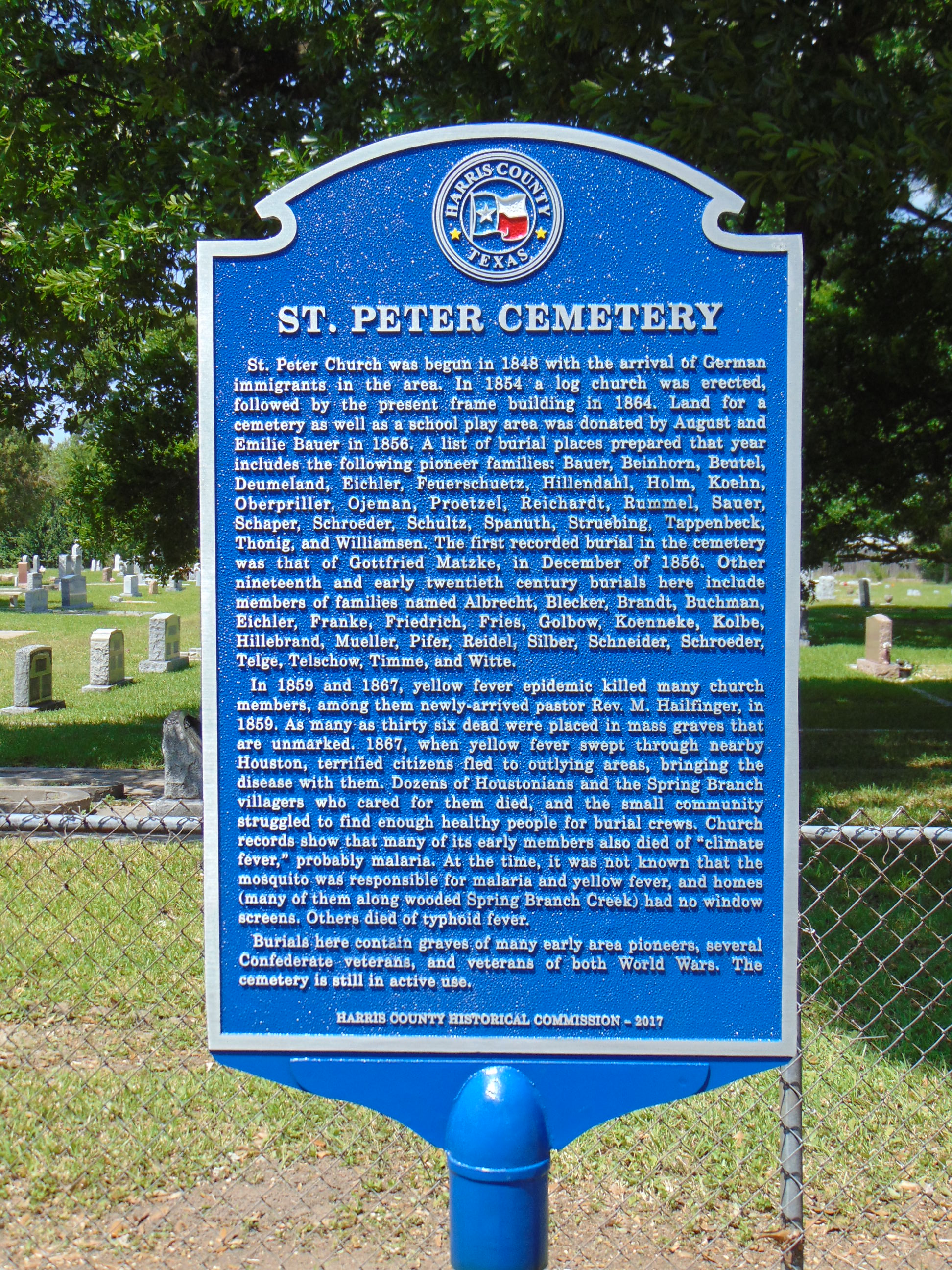 Oberpriller, Ojeman, Proetzel, Reichardt, Rummel, Sauer, Schaper, Schroeder, Schultz, Spanuth, Struebing, Tappenbeck, Throing, and Williamsen. The first recorded burial in the cemetery was that of Gottfried Matzke, in December of 1856. Other nineteenth and early twentieth century burials here include members of families named Albrecht, Blecker, Brandt, Buchman, Eichler, Franke, Friedrich, Fries, Golbow, Koenneke, Kolbe, Hillebrand, Muller, Pifer, Reidel, Silber, Schneider, Schroeder, Telge, Telschow, Timme, and Witte.
Oberpriller, Ojeman, Proetzel, Reichardt, Rummel, Sauer, Schaper, Schroeder, Schultz, Spanuth, Struebing, Tappenbeck, Throing, and Williamsen. The first recorded burial in the cemetery was that of Gottfried Matzke, in December of 1856. Other nineteenth and early twentieth century burials here include members of families named Albrecht, Blecker, Brandt, Buchman, Eichler, Franke, Friedrich, Fries, Golbow, Koenneke, Kolbe, Hillebrand, Muller, Pifer, Reidel, Silber, Schneider, Schroeder, Telge, Telschow, Timme, and Witte.
In 1859 and 1867, yellow fever epidemic killed many church members, among them newly-arrived pastor Rev. M. Hailfinger, in 1859. As many as thirty six dead were placed in mass graves that are unmarked. In 1867, when yellow fever swept through nearby Houston, terrified citizens fled to outlying areas, bringing the disease with them. Dozens of Houstonians and the Spring Branch villagers who cared for them died, and the small community struggled to find enough healthy people for burial crews. Church records show that many of its early members also died of “climate fever,” probably malaria. At the time, it was not known that the mosquito was responsible for malaria and yellow fever, and homes (many of them along wooded Spring Branch Creek) had no window screens. Others died of typhoid fever.
Burials here contain graves of many early area pioneers, several Confederate veterans, and veterans of both World Wars. The cemetery is still in active use.
The Harris County Cemetery and Home - Marker Dedicated April 18, 2018
Marker Text:
The first officially recorded Harris County Cemetery was established for the burial of deceased paupers in 1904 on the Harris County Poor Farm. Originally located along White Oak Bayou from 1882 until 1894, it was moved to an area that is now part of West University Place. 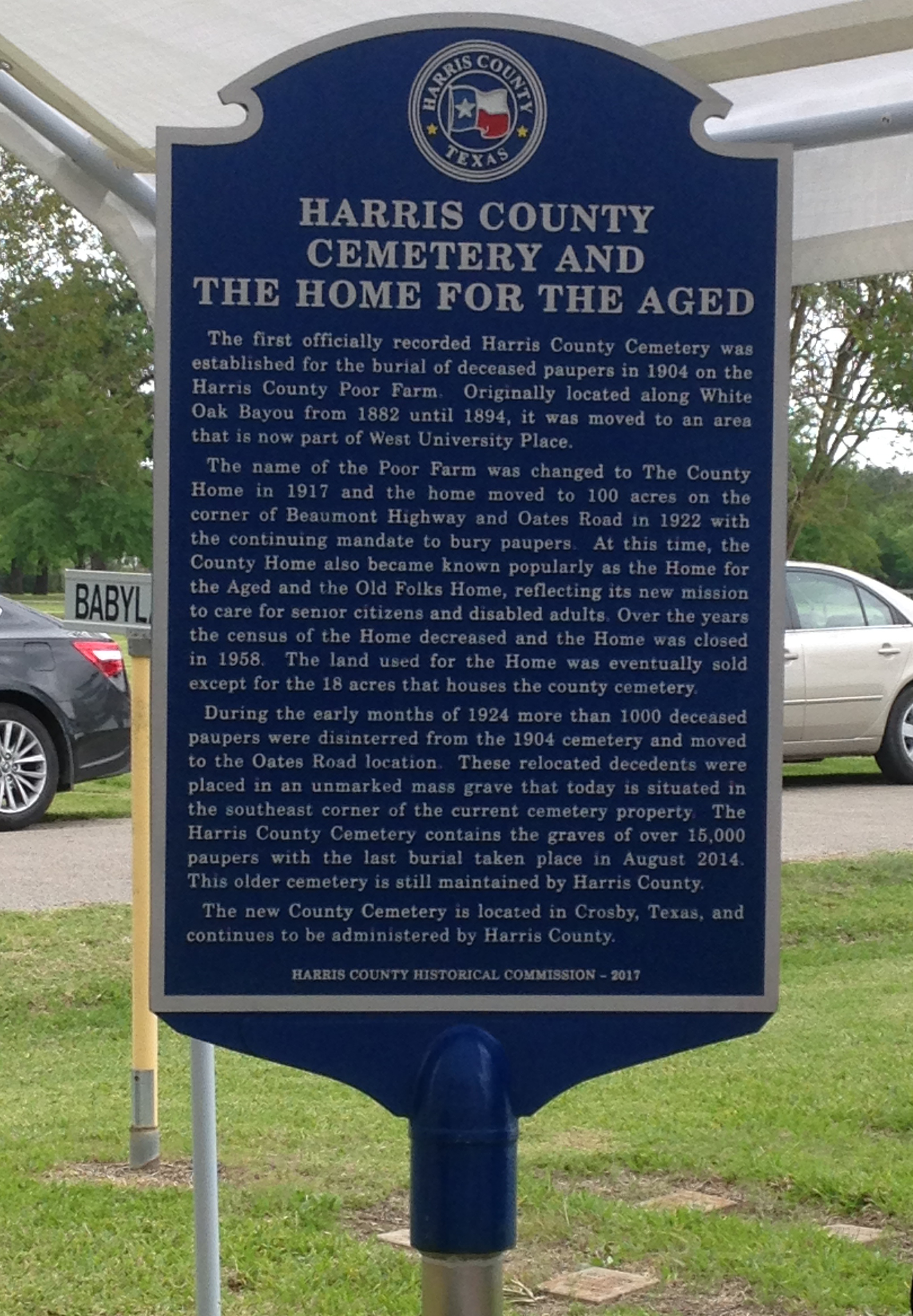
The name of the Poor Farm was changed to The County Home in 1917 and the home moved to 100 acres on the corner of Beaumont Highway and Oates Road in 1922 with the continuing mandate to bury paupers. At this time, the County Home also became known popularly as the Home for the Aged and the Old Folks Home, reflecting its new mission to care for senior citizens and disabled adults. Over the years the census of the Home decreased and the Home was closed in 1958. The land used for the Home was eventually sold except for the 18 acres that houses the county cemetery.
During the early months of 1924 more than 1000 deceased paupers were disinterred from the 1904 cemetery and moved to the Oates Road location. These relocated decedents were placed in an unmarked mass grave that today is situated in the southeast corner of the current cemetery property. The Harris County Cemetery contains the graves of over 15,000 paupers with the last burial taken place in August 2014. This older cemetery is still maintained by Harris County.
The new County Cemetery is located in Crosby, Texas, and continues to be administered by Harris County.
Marker Narrative Marker Invitation Marker Dedication Program Photographs
Rest Lawn Cemetery - Marker Dedicated March 16, 2019
Marker Text:
Rest Lawn Cemetery is one of the oldest graveyards in the historically African-American community of Acre(s) Homes, located about twelve miles northwest of downtown Houston. The community was developed by businessman Alfred A. Wright, beginning in 1910. By the 1950s the area was considered the “largest unincorporated Negro community the southern United States,” before being annexed to Houston, 1967 – 1974.
The cemetery was founded by Mrs. Robert E. Doty (1894 – 1974), who purchased 9.88 acres in the Phillip Thompson survey on February 26, 1932. On March 12, 1932, she dedicated Rest Lawn Cemetery as a two-acre subdivision of that parcel, the cemetery’s northwest corner being at Wheatley Street and Ferguson Way. Seven family lots and four single spaces were sold over the next ten years, but it is uncertain whether there were any burials during this period.
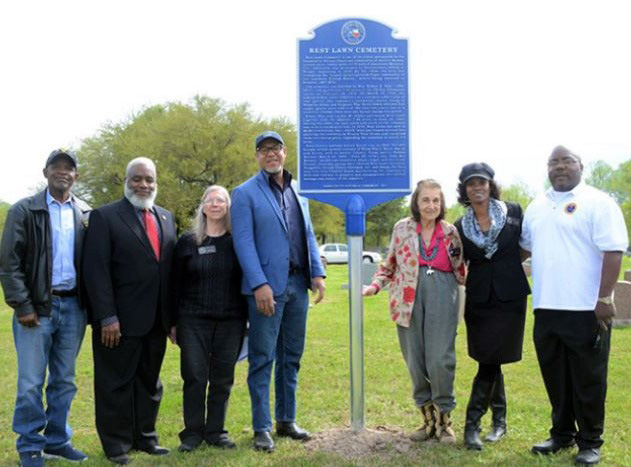 Elmer Hay and Luther M. Inkley purchased Rest Lawn together with the adjacent 7.88 acres on June 18, 1942. During the 1950s the land north and south of the cemetery was sold as residential lots. In 1970, Rest Lawn was sold to MJM Cemeteries, Inc., which later purchased several lots abutting the cemetery on Prairie View Street and converted them into burial plots, expanding the cemetery to nearly 3.2 acres.
Elmer Hay and Luther M. Inkley purchased Rest Lawn together with the adjacent 7.88 acres on June 18, 1942. During the 1950s the land north and south of the cemetery was sold as residential lots. In 1970, Rest Lawn was sold to MJM Cemeteries, Inc., which later purchased several lots abutting the cemetery on Prairie View Street and converted them into burial plots, expanding the cemetery to nearly 3.2 acres.
Rest Lawn’s earliest known burial was in 1943. Notable burials include several veterans of World War I, World War II, and Korea, well as Austin County, Texas native Weldon Bonner (March 22, 1932 – June 29, 1978), aka “Juke Boy Bonner,” an African-American blues singer and musician. Several volunteer groups have cleaned Rest Lawn for years. Nonprofits Second Chance Outreach, Inc. and Omega Psi Phi’s Iota Iota Iota Chapter began maintaining the cemetery in 2012 and continue to preserve and commemorate the cultural heritage and history of the cemetery.
Marker Narrative Marker Dedication Photographs